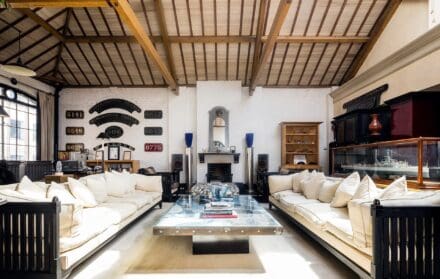
In celebration of London’s most spectacular staircases
Discover the architectural marvels hiding in some of the capital's most famous buildings
If you like looking at concrete and metal, appreciating the intricacies of good design and the consequences of hard labour, London is a city for you. Like New York, Paris and Tokyo, the variety of architectural styles in England’s capital is quite staggering. Whether you’re into Tudor pubs or 1960s brutalist monoliths, there are building styles to inspire every sort of armchair architect.
Sometimes, though, the most interesting parts of a building can be found on the inside. Forget fancy façades, often it’s staircases that constitute a structure’s crowning glory. In London’s most successful buildings, staircases are transportation vessels, static vehicles that make a journey feel special – even if the destination is only ten steps away.
Tate Britain, Millbank

The Tate galleries, clearly, aren’t shy of a fancy staircase. The original Tate, the Britain, boasts its very own, built as part of a £45 million refurb of the famous Millbank landmark that completed in 2013. Located in the centre of the rotunda, an elaborate entrance hall replete with ornate pillars and a circular balcony, the staircase is as Insta-friendly as it gets. This is in part thanks to the patterned terrazzo floor and the pleasing geometry of the design, which is almost too perfect. Descend into the bowels of the Tate and enjoy a coffee or two, then head back up and admire the domed glass ceiling above.
Tate Modern Blavatnik Building, Bankside

Perhaps London’s most photographed staircase, the curved concrete wonder located on the ground floor of the Blavatnik Building is reason alone to head to the iconic Bankside gallery. Part of the 2016 Herzog & de Meuron-designed extension to the former power station, its impossibly smooth, cold surface begs to be touched as you walk under it, the staircase’s intimidating mass suspended above you. There’s something undeniably satisfying about the long continuous line that connects from the ground floor to the storeys above; it draws the eyes upwards towards the many galleries that are housed in this vertical maze of a building.
Hide restaurant, Piccadilly

One of the most interesting-looking staircases in London features not in a historic landmark, nor a state-of-the-art skyscraper, but a restaurant. Ollie Dabbous’ Hide restaurant in Mayfair may have received rave reviews for the food when it opened in 2018, but the star of the show may well be the Gaudi-esque staircase that dominates the interior. Part of a build that cost a reported £20 million, its swirling, hypnotic design was penned by Atmos Studio, and it’s a beauty from all angles.
Royal National Theatre, South Bank
 |  |
Depending on who you speak to, and whether or not they have any taste, the National Theatre may come up in conversation as one of London’s best or worst buildings. It is, of course, the former, and one of the jewels in the Southbank Centre’s crown. Finished in 1976, it’s a perfect example of why brutalism is such an infamous style of architecture – its use of vast swathes of concrete, sharp lines and harsh angles makes it stand out among the many buildings that line the Thames. It also has one of the city’s best staircases.
You have to walk up another set of steps and across a small walkway to get the best view of it, which is incidentally the best view of the theatre. The staircase is open to the elements and is quite small, and from this particular angle gets lost among the sharp strips of grey of the rest of the building. Its bulbous, rounded section gives it away though, and is representative of a time when the future was concrete.
City Hall, Southwark
 |  |
Variously nicknamed the ‘Helmet’, the ‘Glass Testicle’ (by Ken Livingstone), and ‘The Onion’ (by Boris Johnson), City Hall is certainly one of the more distinctive structures located along the River Thames. Designed by Norman Foster, its bulbous shape makes it instantly recognisable, especially against the backdrop of the neighbouring Tower Bridge. While its exterior divides opinion, few can argue against the spectacular staircase within – an endlessly winding orange peel of a design that you might recognise from productions as varied as The Apprentice and the 2015 James Bond film Spectre.
Queen’s House, Greenwich

A monumental name for a monumental building. Named after Anne of Denmark, King James I’s queen, who commissioned it in 1616, Queen’s House is one of the UK’s most important architectural landmarks. Designed by Inigo Jones, it’s noted as the first example of classical architecture to be built in the UK. It’s a Grade I-listed masterpiece and, of course, has a great staircase. The Tulip Stairs are an original part of Jones’s design, and they were Britain’s first self-supporting spiral stairs, quite the achievement back in the 1600s. You can ordinarily visit them for free and marvel at their geometric perfection from virtually any angle, although the view from the bottom is arguably the best.
Bevin Court, Finsbury
 |  |
Bevin Court may just house the coolest staircase you’ve never seen. A modernist post-war housing solution completed in 1954, Bevin Court was designed by lauded architect Berthold Lubetkin, who chose a bomb-destroyed site in Finsbury for his vision (which has since been Grade II-listed). While not open to the public, arrange permission to visit and you’ll see why. Connecting all floors is a vortex of a staircase that looks as if it is straight out the mind of graphic artist M.C. Escher, with walkways veering off at all angles and a striking red paint job, restored to the original 1950s spec. It showcases the ingenuity of Lubetkin and how interesting design shouldn’t be solely reserved for luxury apartment complexes.
Lloyd’s Building, City of London

One of the most distinctive buildings in the City of London, the Richard Rogers-designed Lloyd’s Building is as innovative as it is polarising. Its Marmite exterior is a signature of Roger’s. Built in the ‘bowellism’ style, its design features the building’s innards on its outside – its intestinal network of tubes, lifts, wiring, pipes and electrical ducting are visible, saving room for an uncluttered, highly adaptable interior. The Centre Pompidou in Paris, Roger’s masterpiece, is designed in the same way. Inside, the vast atrium is dominated by a series of criss-crossing escalators, connecting all floors as light floods in through the glass ceiling. Yes, they are not staircases in the traditional sense, but this is what a utopian future looked like in 1986. Walking up stairs is overrated anyway.
Liberty, West End

Liberty is a respite from the usual department store of the 21st century. Far from gaudy or brash, it’s a classy establishment and one that’s enjoyable to spend time in. Oscar Wilde was a regular, going as far to say, ‘Liberty is the chosen resort of the artistic shopper’. There are no DJs playing obnoxious music here, or integrated skate bowls like its rivals. It’s instead pleasingly old fashioned, with more dark wood, both inside and out, than a St James’s’ member’s club. Its main staircase is a case in point, winding up through the store in glorious fashion. The timber used throughout was actually sourced from two dismantled ships, the HMS Impregnable and HMS Hindustan. Liberty’s nautical pedigree runs deep.









